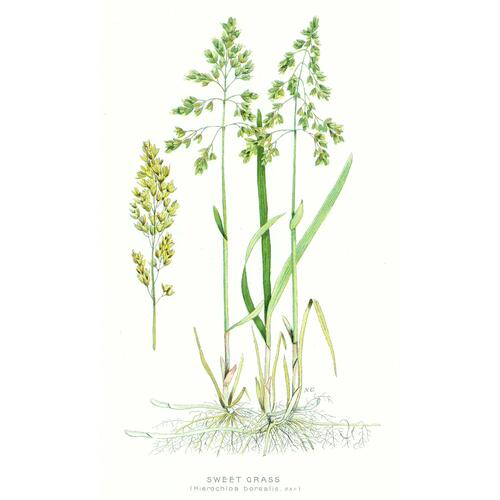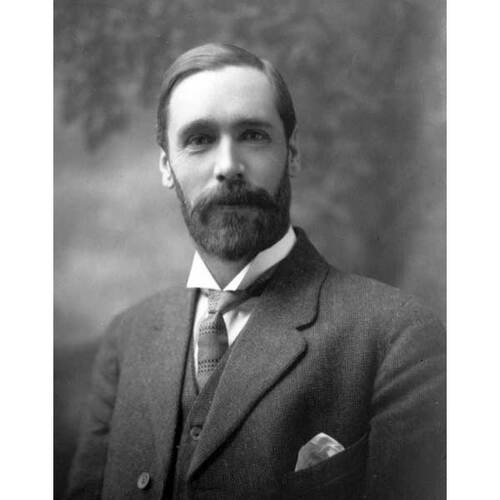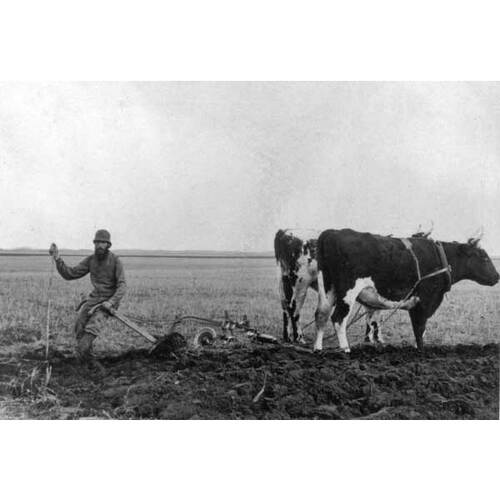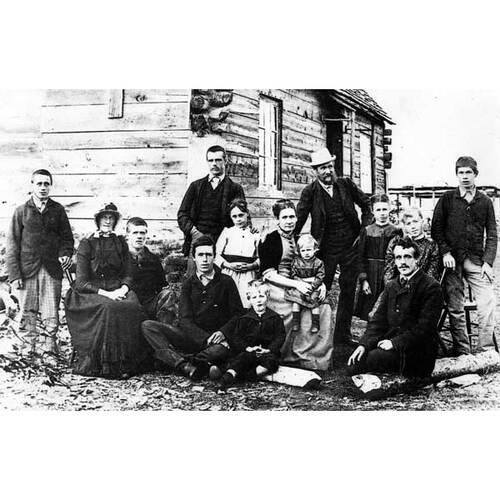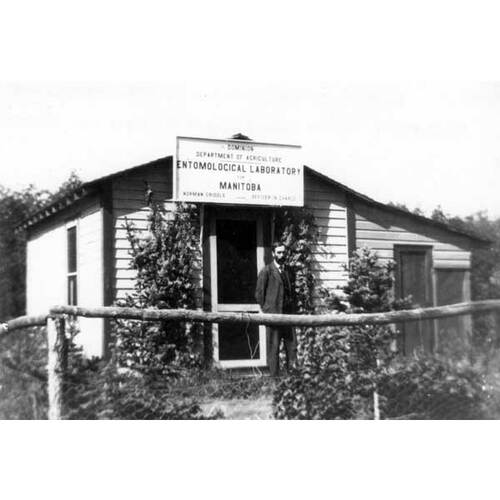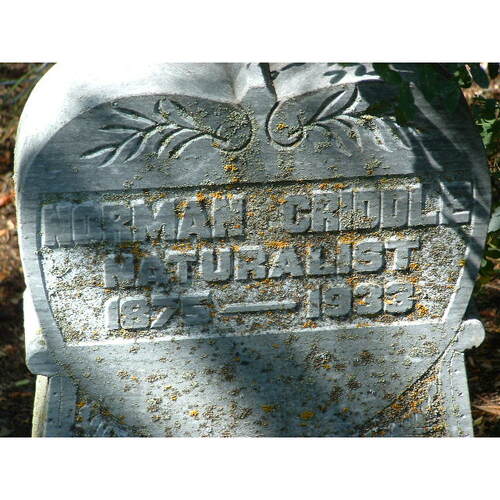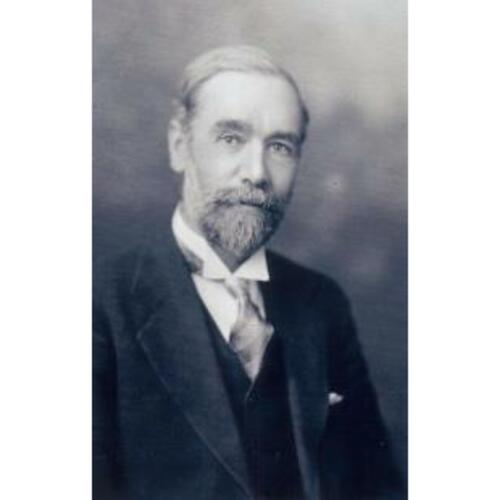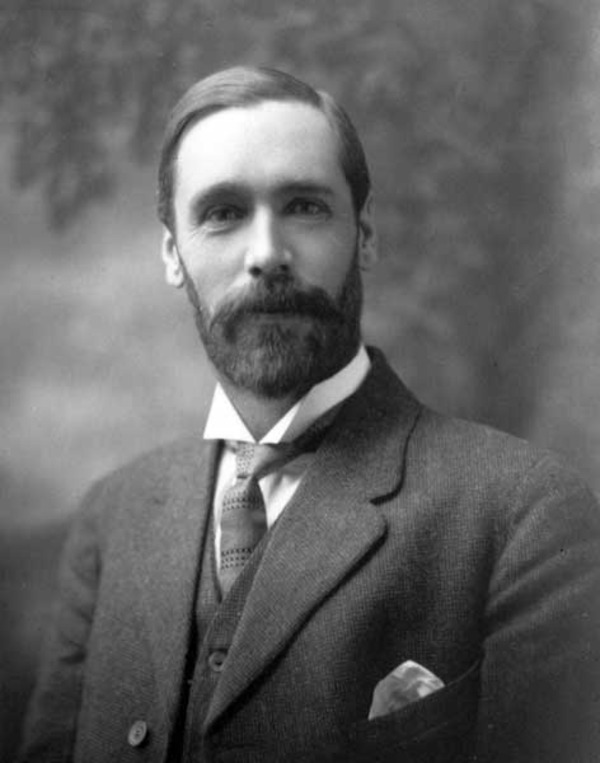
Source: Link
CRIDDLE, NORMAN, farmer, artist, entomologist, naturalist, office holder, and author; b. 14 May 1875 in Addlestone, England, eldest son of Percy Criddle and Alice Nicol; d. unmarried 4 May 1933 in Brandon, Man.
While in Germany to further his education, Norman Criddle’s father, Percy, took Elise Harrer as his mistress and in 1867 she moved with him to London, where he became a general merchant. She lived in a flat over his business. The couple had several children. In September 1874 Percy married Alice Nicol, a highly educated woman, and they set up house in Addlestone. Norman was their first child and three more children had been born by 1880. Two years later Percy, Alice, Elise, and their nine children immigrated to Canada. At about this time, for unknown reasons, Elise and her children adopted the family name Vane, although they had used the Criddle name in England. Percy and his combined families established a homestead near what would become the community of Treesbank, Man., southeast of Brandon, in a district that would be known as Aweme.
In the early years on the prairie, the families lived in a draughty four-room log house. Money and food were scarce. Percy planned the farm, but delegated many of its operations to his children. Alice provided the only education they had, mostly on winter evenings. Sports and natural history were family pastimes.
Norman Criddle began drawing and painting flowers and insects in about 1893 and he exhibited at least 125 illustrations of flowering plants at the Brandon fair in 1898. His work was hampered by lack of money for supplies. He sent some flower drawings for identification to Ottawa, where they attracted the attention of the dominion entomologist and botanist, James Fletcher*. On the family farm, assisted by his half-brother Harry Vane, he fought a grasshopper outbreak that plagued southern Manitoba from 1898 to 1903. They invented a sleigh-like pan filled with burning wood that, when drawn by a horse, disturbed the grasshoppers so that they jumped into the fire. In 1900, while surveying the outbreak, Fletcher visited Aweme and became firm friends with Criddle. The following year Criddle’s diary reports, “I, in company with Harry Vane, discovered a simple remedy for killing locusts.” This treatment won recognition as the “Criddle Mixture,” an arsenical insecticide bait that would be used for over 30 years. The outbreak was the final appearance of the now extinct Rocky Mountain locust, Melanoplus spretus, the last known living collection of which was made by Criddle in 1902.
Criddle’s meeting with Fletcher led to official recognition of his mixture and employment in demonstrating its use to farmers. Also, there were commissions for artwork. In the winter of 1904–5 he travelled to Ottawa to complete coloured drawings for a government publication written by Fletcher and George Harold Clark, Farm weeds of Canada (Ottawa, 1906). This occasion was his first opportunity to mingle with members of Canada’s scientific community. For the next eight years he divided his time between farming, botanical illustration, and work on weeds and seed analysis for the Department of Agriculture in Calgary.
In February 1912 Charles Gordon Hewitt*, who had succeeded Fletcher, offered Criddle his first entomological position. He was to be appointed for the summer to investigate agricultural insect pests of Manitoba; however, the government’s lack of funds delayed the appointment until 1913. In March 1914 he was named officer in charge of the Dominion Entomological Laboratory in Treesbank, a position he would hold until his death. His first challenge was to construct the laboratory. Since his initial quote of $165 was deemed exorbitant, he was obliged to wait a year and use his family’s donated labour to save the government $57. His father, Percy, built a wing on the family house to accommodate the workers and visitors Norman anticipated. Among these would be his assistants, Roy Mason White, hired in 1922, and Richard Henry Handford, who would start in 1928. During the 1920s John Braithwaite Wallis, an amateur entomologist and expert on tiger beetles, and Ralph Durham Bird, an ecologist from the University of Oklahoma, were frequent visitors.
After his encounter with Fletcher in 1900, Criddle had sent yearly accounts of insect pests to the dominion entomologist. From 1911 to 1913 and from 1921 onwards Criddle published annual reports of insect pests; from 1929 until his death they were written with Alvin Valentine Mitchener of the University of Manitoba. These documents are a mine of information, much of it still relevant but often neglected. For example, until the late 1990s it was believed that the first record of the orange wheat blossom midge in the prairie provinces was made by Mitchener in 1954; however, this insect had been reported in Manitoba by Criddle in 1901.
At his appointment in 1913 Criddle had been commissioned to research the Hessian fly and wheat stem sawfly and in 1915 he produced a publication describing the life stages and habits of both; a scientific study of the life history of the sawfly would appear in the Canadian Entomologist (London, Ont.) in 1923. He worked on grasshoppers throughout his career and published items ranging from recipes for control to detailed investigations of grasshopper biology and possible reasons for outbreaks. He wrote about the nymphal stages of more than 30 species and an account of the ecology and diet of about 80 species. In October 1931, working with Handford and White, he was the instigator of the first prairiewide fall survey of grasshopper eggs to predict the following summer’s infestation.
Not just a crop-protection entomologist, Criddle had diverse interests in natural history. Of his approximately 125 publications, about 40 per cent deal with pest control, 10 per cent are basic biological studies of insects, 25 per cent concern ornithology, and the remaining 25 per cent are on a variety of subjects, including plants and mammals. Three on mammals were co-authored with his brother Stuart Criddle. Having witnessed the transition from natural prairie to agricultural landscape, he was an early proponent of habitat conservation.
Well regarded by his contemporaries for his contributions to economic entomology and natural history, Criddle was awarded an honorary diploma in agriculture by the Manitoba Agricultural College in March 1933. This “highest honour the institution could bestow” was an occasion for great celebration by colleagues, friends, and family. At his death shortly afterwards, it was noted in the Canadian Entomologist (Orillia, Ont.) that he was “the best informed field naturalist in the whole of Canada.” Described as “a man of great kindliness, modesty and quiet, persistent industry,” he had taken “so prominent and authoritative a part in all prairie entomological activities” that they experienced the loss of “an irreplaceable colleague, friend and leader in the science.” In his lifetime no fewer than 29 insect species and one genus were named after him.
Criddle’s impact on economic entomology persists into the 21st century. His studies of the biology of the wheat stem sawfly, the Hessian fly, and many species of grasshoppers are still definitive and cited by researchers. The grasshopper forecast that he pioneered continues annually in the prairie provinces. His ideas on the integration of organisms into ecosystems were well ahead of their time. In one of his last publications, he described habitats of 31 grasshopper species. He showed that the habitats could be grouped into 13 ecological associations and for each association he documented the characteristic dominant plants, vertebrates, and grasshopper species. His understanding of the interconnectedness of prairie ecosystems was out of step with the fashion of the time, but would not be out of place in the approach of a modern ecologist.
AM, P 4661–65 (Norman Criddle fonds). Entomological Soc. of Man., Arch. (Winnipeg), N. Criddle papers. Alma Criddle, Criddle-de-diddle-ensis: a biographical history of the Criddles of Aweme, Manitoba, pioneers of the 1880’s (Winnipeg, 1973). Arthur Gibson and H. G. Crawford, “Norman Criddle,” Canadian Entomologist (Orillia, Ont.), 65 (1933): 193–200 [includes a partial list of Criddle’s pubs.]. N. [J.] Holliday, “Norman Criddle,” Entomological Soc. of Can., Bull. (Ottawa), 37 (2005): 10–19. Hoyes Lloyd, “Norman Criddle, 1875–1933,” Canadian Field-Naturalist (Ottawa), 47 (1933): 145–47. Man., Conservation and Water Stewardship, Parks and natural areas branch, “Criddle/Vane Homestead Provincial Heritage Park”: www.gov.mb.ca/conservation/parks/popular_parks/western/criddle.html (consulted 1 April 2013). P. W. Riegert, From arsenic to DDT: a history of entomology in western Canada (Toronto, 1980); “Norman Criddle,” in Biographical dictionary of American and Canadian naturalists and environmentalists, ed. K. B. Sterling et al. (Westport, Conn., 1997). “Wawanesa: a prairie heritage”: epe.lac-bac.gc.ca/100/200/301/ic/can_digital_collections/wawanesa/E/index.html (consulted 1 April 2013).
Cite This Article
N. J. Holliday, “CRIDDLE, NORMAN,” in Dictionary of Canadian Biography, vol. 16, University of Toronto/Université Laval, 2003–, accessed December 12, 2025, https://www.biographi.ca/en/bio/criddle_norman_16E.html.
The citation above shows the format for footnotes and endnotes according to the Chicago manual of style (16th edition). Information to be used in other citation formats:
| Permalink: | https://www.biographi.ca/en/bio/criddle_norman_16E.html |
| Author of Article: | N. J. Holliday |
| Title of Article: | CRIDDLE, NORMAN |
| Publication Name: | Dictionary of Canadian Biography, vol. 16 |
| Publisher: | University of Toronto/Université Laval |
| Year of publication: | 2014 |
| Year of revision: | 2014 |
| Access Date: | December 12, 2025 |


